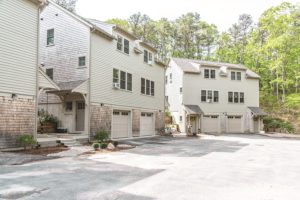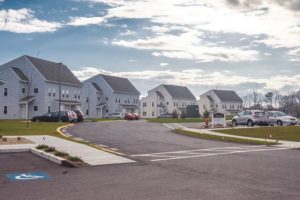One of the reasons so few developers are interested in building affordable housing on the Outer Cape is the extreme complexity of funding such projects. Another reason: the profits are strictly limited by state regulations.
Each unit in an affordable rental complex can cost $350,000 to $400,000 to build. That includes up-front costs like design and engineering, financing fees, and loan interest, as well as construction. (The cost to towns for these developments is much lower; see related story on page A13.)

The expenses start adding up as soon as planning for a project begins. And even though outside funding can be expected, developers have to provide up-front money to carry the project until it kicks in.
Developers can look for economies of scale, but, in many communities, including on the Outer Cape, opposition to large-scale projects can be intense. In Truro, where Ted Malone of Community Housing Resource has taken on a 39-unit development known as the Cloverleaf, he has been attacked, without evidence, as an unscrupulous profiteer and was publicly derided by a member of the Truro Planning Board. The Cloverleaf, now tied up in what most town officials consider a frivolous lawsuit, will be the largest affordable housing complex in town but will still leave Truro far below the state’s recommended 10-percent minimum of affordable housing stock.
“It is much more efficient to build 50 units,” said Aaron Gornstein, president of Preservation of Affordable Housing (POAH), a large nonprofit developer based in Boston that is now looking into projects on the Cape. Gornstein pointed out that scale is also important when it comes to the management of affordable properties. “If you’re only getting rent revenue from 10 units, it’s difficult,” he said.
Where Funds Come From

Financing for most affordable rental housing comes from three sources: borrowed money, equity from the sale of low-income housing tax credits, and grants.
Some of the borrowing is similar to the kind home owners do — to be paid back over time and with interest. But those loans are hard to get for affordable projects. Developers can secure loans only if they can show the project will produce enough revenue to pay back the debt after operating expenses.
“Some projects with deep subsidies have no ability to put mortgages on them,” said Charlie Adams, regional vice president of Pennrose, the company that developed the 65-unit Village at Nauset Green in Eastham.

For that reason, Adams said, a traditional mortgage is usually only a small part of the financing package behind an affordable development. “It’s 20 percent at most,” he said.
Depending on the characteristics of the development, government programs can make it possible for some debt on affordable projects to be deferred, meaning the borrowed money can be paid back when the cash flow of the project allows or when the project is sold. For example, the HOME Investment Partnership Program of the state Dept. of Housing and Community Development has zero-percent interest and a 30-year deferred payment term. But that program has a maximum of $750,000 to $1 million available per project.
Some state and federal loans can be completely forgiven if the project remains affordable for an extended period.

The biggest sources of funding for affordable rental projects are federal and state tax credits. In fact, tax credits generally represent about 70 percent of a developer’s seed money for a large project. They can go to projects in which at least 20 percent of the units are reserved for people who earn less than half the Area Median Income (AMI), or for projects in which a minimum of 40 percent of the units are for tenants who earn 60 percent or less of AMI. The units must remain affordable for a minimum of 30 years. Qualifying projects must have at least 20 units.
Understanding these tax credits is a specialty unto itself. Here’s how they work: The developer sells the tax credits to investors to raise cash. That up-front money allows the developer to build and offer below-market-rate rents. Investors use the credits to defray taxes for 10 years, so a $100 credit is worth $1,000.

There are still other funding mechanisms affordable housing developers need to know about — bond and grant programs, and federal and state subsidies.
Most of these funding sources are available to both for-profit and nonprofit developers. But it’s clear why towns do not generally play the developer role. They have a hard enough time finding municipal finance staff to do everyday accounting work. Managing a complex development project over the long timeline involved is well beyond towns’ capacities.
Towns do play different and important roles. In Truro, the town was given the land for the Cloverleaf project by the state and designated it for affordable housing. In Wellfleet, voters approved a $3.8-million water system upgrade last September that will ensure the required backup capacity for 95 Lawrence Road, where the town is seeking proposals to build 46 units of affordable housing.
Is Anybody Getting Rich?

One thing both for-profit and nonprofit developers agree on is that nobody is getting rich building affordable housing.
“These deals are no different, whether for profit or nonprofit,” said Charlie Adams. “The not-for-profits need to get a developer fee as well as us.” His company, Pennrose, is a for profit.
And either way, the state tightly regulates how much money developers can make.
Jay Coburn, CEO of the Community Development Partnership in Eastham, said the regulations ensure that large sums are not going into the pockets of the developers.

“The profits are capped at 10 percent, and the overhead at 10 percent,” Coburn said. The developer has to pay operating expenses, such as office and staffing, out of the overhead, he explained.
According to housing experts, developers sometimes even defer their own fees to cover pre-opening costs. They do so hoping to recoup the money over time from rent payments.
So why do developers build affordable housing? Speaking for his own nonprofit, Gornstein said its mission is to provide as much affordable housing as it can. “The nonprofit’s goal is to maximize affordability,” he said. “Not all for-profits do that.”



